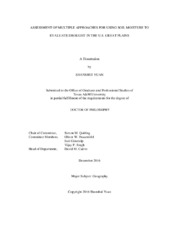| dc.description.abstract | Drought is a natural phenomenon induced by precipitation deficiency and it impacts economy, environment and society. The drought monitoring tools include direct measurements, such as precipitation, soil moisture and streamflow and indirect estimations, like drought indices and model simulations. The newly developed North American Soil Moisture Database (NASMD) provides quality-controlled soil moisture observations over the entire U.S. to help assess the reliability of these drought monitoring tools. In this dissertation study, we focused on the assessment of drought indices and model simulated soil moisture using in situ data from NASMD.
First, we focused on four soil moisture statistics: percentile, trend, variability and persistence in 0-10 cm and 0-100 cm soil layers. The result reveals that the crop moisture index well represent the soil moisture conditions in the top 100 cm soil layer based on higher correlation, more similar trend, variability and persistence. In the top 10 cm soil layer, no drought index is the most appropriate one for all the statistics. In general, drought indices considering potential evapotranspiration (PET) are more appropriate for representing soil moisture in 0-10 cm soil layer. Then we developed a more realistic Palmer Drought Severity Index (PDSI) using two-source PET model. Based on the comparison with original PDSI and Penman-Monteith based PDSI, we found the choice of PET method would impact the spatial and temporal patterns of drought and the drought severity during extreme drought events. Thirdly, we tested the reduced optimal interpolation (ROI) method to soil moisture in Oklahoma and compared it with two geo-statistical interpolation methods: the inversed distance weighting (IDW) method and Cokriging method. The ROI method is significantly more accurate than IDW and it also outperforms Cokriging. We demonstrate that ROI can recreate soil moisture at unsampled locations. Last, we assessed the accuracy of soil moisture in Earth system models (ESMs) by using in situ and satellite observations. The results show that models can reproduce the seasonal variability in soil moisture over CONUS but with overestimation in the western U.S. and underestimation in the eastern U.S. There are significant regional and inter-model variations in performance. | en |


